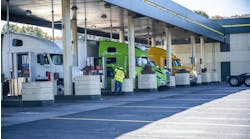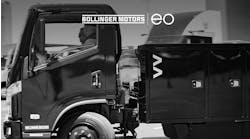LONG BEACH, CA. With diesel fuel prices well below record highs seen earlier in the decade and so much attention focused on autonomous vehicles, the spotlight on natural gas that shined so brightly just a few years ago has dimmed a bit.
That has manifested in lower sales of natural gas-powered trucks and a slowing of planned fueling stations. At the Advanced Clean Transportation (ACT) Expo this week, however, it was clear the natural gas market is methodically moving forward, driven by new forces.
“The tide has shifted,” said Dean Stapleton, senior manager of alternative fuels for Penske Truck Leasing, during a panel discussion at the annual exhibition here. “It is not a money play. It is now a sustainability play, a lot of times driven by the shipper.”
Natural-gas proponents attending the ACT Expo acknowledged many of the same barriers still exist, starting with the initial higher vehicle cost, compared with diesel.
“The biggest challenge is overcoming the cost of the vehicle,” Mike Castell, director of fleet procurement for United Parcel Service, said as he discussed the company’s achievement of one billion miles driven with alternative fuels in a five-year period.
Long-term residual values remain uncertain, and fueling infrastructure is still lacking in some portions of the U.S.But with the passage of time comes a better understanding on how to overcome other obstacles.
For example, “range anxiety” – once a major fear of fleets – is being eased through the slow growth of fueling stations and advancements in tank options.
Matt Matheson, CEO and president of Matheson Trucking Inc., said about 10% of his overall fleet is powered by natural gas. The company ships mail for the U.S. Postal Service throughout the western U.S., and found using three natural gas tanks has solved a main concern of drivers running out of fuel during a run.
“It was new and different but it has worked out very well,” he said.
He added: “Range ability is not as big an issue but the tanks are costly.”
New technology is further alleviating the worries about running out of fuel, said William Nowicke, COO and president at Agility Fuel Solutions.
Products such as Agility’s Blue iQ, which integrates with Cummins Connected Diagnostics, are better equipped to determine natural gas-specific problems and to more accurately read how much fuel is left in the tank.
Blue iQ includes a “limp home mode” so drivers can get safely out of traffic at low fuel levels.
Nowicke said fewer sensors and elimination of diesel particulate filters makes the maintenance of natural gas-fired trucks easier than conventional diesels.“Natural gas trucks can outperform traditional diesel models on a cost-per-mile basis after five years,” he explained.
Stapleton said Penske’s leasing options are helping smaller fleets take their first steps into the natural gas market.
Leasing removes the higher upfront purchases costs and eliminates the need to upgrade in-house maintenance shops to handle the trucks, he noted.
Already this year, there are signals the natural gas market is gaining traction.
In April, research firm ACT reported that U.S. and Canadian natural gas heavy-duty sales have accelerated, but remain only about 3% share of the overall market.
“The best January in the past three years set up the positive year-to-date February performance,” said Steve Tam, ACT’s vice president, in a statement.
Penske’s Stapleton suggested it would only take one unfortunately global incident for the mood surrounding natural gas to change instantaneously.
“If oil goes to $80-to-$90 a barrel, we won’t be able to keep the phone on the hook,” he said.





